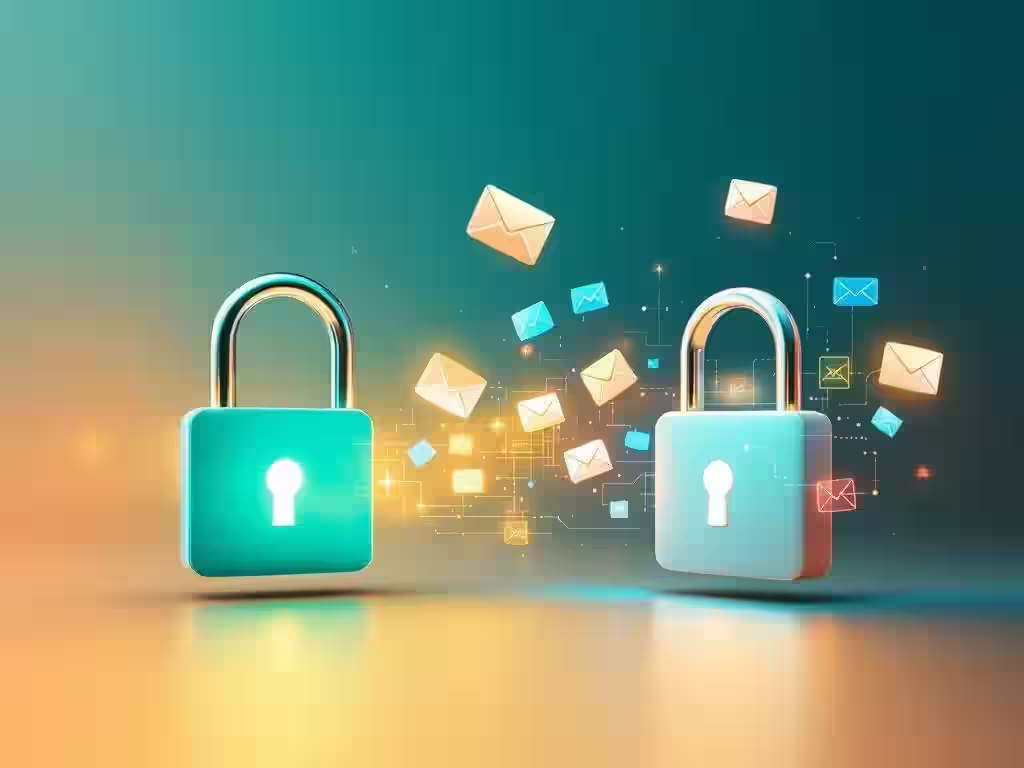Email encryption protects against Business Email Compromise. Transforms messages to ciphertext using cryptography. AMVIA delivers implementation, 24/7 support, threat response, archive.

Why is email encryption critical for your business? 64% of global businesses report Business Email Compromise (BEC) attacks with $150,000 average financial loss per incident. Email encryption transforms readable messages into unreadable ciphertext accessible only to authorized recipients. Two approaches: Transport-Level Encryption (STARTTLS) encrypts in transit but not at rest; End-to-End Encryption (OpenPGP) encrypts throughout entire lifecycle. Public-key cryptography uses public key (shared openly) for encryption and private key (kept secret) for decryption. AMVIA delivers enterprise-grade email security including Barracuda Total Email Protection, Microsoft 365 implementation, gateway defense, inbox defense, incident response, cloud archiving, security awareness training. Our 24/7 UK-based support ensures continuous protection. Implementation streamlined through proven methodology minimizing business disruption while maximizing security.
Email has become business communication backbone, making it prime target for cybercriminals. Email encryption transforms message contents into unreadable scrambled text only authorized recipients can decipher. Think of encryption as placing message in secure digital vault where only correct key holders access contents. Even if hackers intercept emails, encrypted contents remain protected from unauthorized access.
This guide explains email encryption mechanics, implementation approaches, AMVIA solutions, and how to protect business communications against sophisticated threats.
Email encryption operates on public-key cryptography foundation, assigning each email account unique digital key pair. This Public Key Infrastructure (PKI) creates elegant solution to secure communication challenges.
Function: Acts like business address - openly available, shareable with anyone needing to send encrypted messages
Distribution: Often stored in public directories, enabling clients, partners, colleagues to find easily when sending sensitive information
Usage: Encrypts outgoing messages from senders to you
Function: Acts like office safe key - must remain secure, never shared
Security: Only way to decrypt messages sent to your public key, ensuring only you read emails intended for you
Critical: Entire encrypted email system security depends on protecting private key with strong passphrase
Step 1: Sender obtains your public key
Step 2: Sender uses public key to encrypt message
Step 3: Encrypted email transmitted (appears meaningless without private key)
Step 4: You decrypt using private key, revealing readable message
Result: Robust security maintaining practical business usability
Technology: Uses STARTTLS to create secure tunnel between email servers
Protection: Encrypts emails during transmission, similar to HTTPS web protection
Activation: Automatic when both sender and recipient servers support STARTTLS
Advantages:
Limitation: Emails may be stored in plaintext on servers, potentially accessible by email provider
Protection Level: Highest security - encrypts at source, remains encrypted in transit and at rest, only decrypts at final destination
Coverage: Messages encrypted even when stored on email servers, preventing email provider access to contents
Standard: OpenPGP represents gold standard for end-to-end email encryption
Advantages:
Consideration: Email metadata (sender, recipient, timestamp) may remain visible to email servers
64% of global businesses report BEC attacks averaging $150,000 financial loss per incident. Cybercriminals target email communications containing financial data, client details, strategic plans, confidential documents.
When employees check email on unsecured networks, malicious actors use packet sniffing tools to intercept login credentials and email contents. Most devices automatically sync with email servers when connecting to any network, potentially exposing sensitive information.
Email encryption provides critical defense rendering messages unreadable even if intercepted. Benefits include business continuity, maintained client trust, regulatory compliance support (GDPR, HIPAA, PCI DSS), protection against sophisticated threats.
AMVIA delivers email security far beyond basic encryption through Barracuda Total Email Protection including:
As Microsoft Partner, AMVIA provides complete Office Message Encryption (OME) implementation including:
AMVIA UK-based technical support provides 24/7/365 expert assistance. Call 0333 733 8050 to speak directly with real experts solving challenges immediately - unlike larger providers offering impersonal support.
Managed Services Include:
AMVIA begins with thorough security assessment evaluating current security posture, analyzing threat landscape, identifying gaps, conducting risk assessment.
Our implementation covers:
AMVIA's comprehensive approach extends beyond encryption to include Advanced Threat Protection, Data Loss Prevention, Information Protection, Cloud App Security, Identity and Access Management.
Email authentication protocols (SPF, DKIM, DMARC) prevent email spoofing and improve organization email reputation.
AMVIA provides comprehensive training ensuring team understands encryption feature usage, broader email security importance, proper adoption procedures.
While email encryption protects message contents, AMVIA implements additional measures:
AMVIA provides comprehensive compliance assistance including GDPR compliance, industry regulation adherence, security policy management, risk assessment, compliance reporting, security audits, penetration testing.
AMVIA's approach includes business continuity planning, disaster recovery solutions, backup and recovery services, incident response planning, crisis management support ensuring email encryption systems remain operational during adverse conditions.
Established 2016, AMVIA provides business IT services to organizations from sole traders to global companies like eharmony and HBO. Experience spans hundreds of UK businesses providing voice, data, cybersecurity services with focus on exceptional customer service.
AMVIA's team combines 15+ years enterprise connectivity and security solutions experience. As Microsoft Partner with extensive VoIP and telephony experience, we bring deep technical expertise ensuring seamless email encryption integration with existing infrastructure.
AMVIA built reputation on simple principle: exceptional technology deserves exceptional customer service. We're human-first alternative providing personal touch and genuine pride delivering outstanding results. From consultation through ongoing support, we deliver dedicated attention larger providers cannot match.
Our approach recognizes email encryption protects team, customers, and peace of mind. This human-centered philosophy ensures solutions designed around business needs, not just technical specifications.
AMVIA's service portfolio extends beyond email encryption to include high-speed broadband, IT security, VoIP systems, Microsoft 365 integration, bandwidth management, AI threat detection, cybersecurity solutions. Integrated approach ensures all communication and security systems work together seamlessly.
AMVIA delivers solutions growing with your business, offering flexibility for SMEs or larger organizations. Pay-as-you-go pricing ensures you only pay for needed services, while scalable infrastructure accommodates business growth without compromising performance.
We stay ahead of cybersecurity threats through intelligent real-time protection evolving with threat landscape. Commitment to ongoing innovation ensures email encryption solutions remain effective against emerging threats.
Email encryption represents fundamental modern business security component, but works best as part of comprehensive approach including reliable connectivity, robust infrastructure, expert support.
Contact AMVIA specialists: 0333 733 8050 (direct to experts, no voicemail) or request consultation. We assess your email security needs, recommend optimal solutions, implement Microsoft 365-compatible protection, and integrate comprehensive cybersecurity strategies protecting business from evolving email threats.
Investment in proper email encryption with AMVIA pays dividends through improved security, enhanced client trust, protection against costly data breaches, peace of mind from working with trusted technology partner. In era where email security threats continue evolving, taking proactive steps with AMVIA's comprehensive solutions isn't just smart business - it's essential for long-term success.
Monthly expert-curated updates empower you to protect your business with actionable cybersecurity insights, the latest threat data, and proven defences—trusted by UK IT leaders for reliability and clarity.
